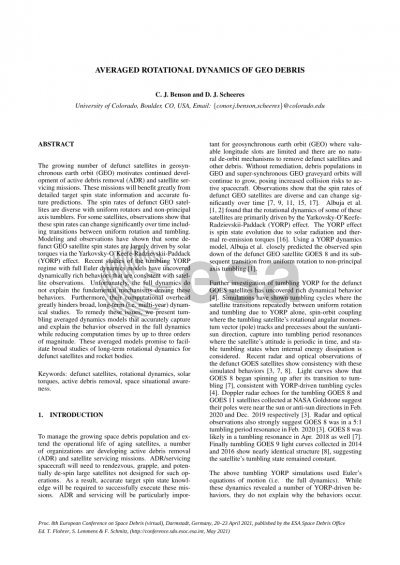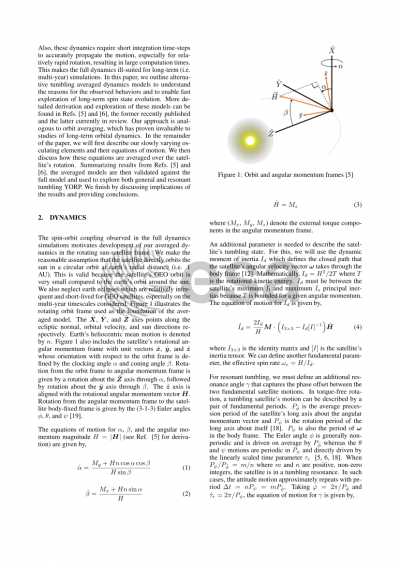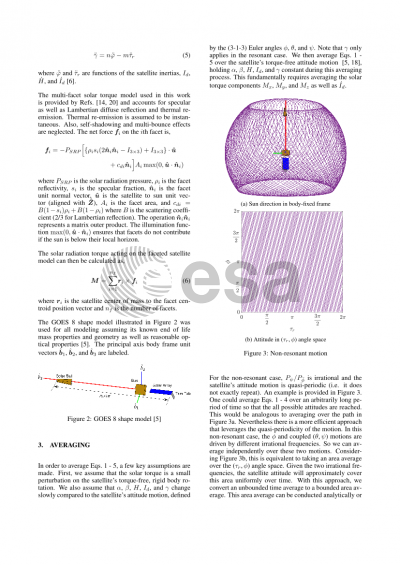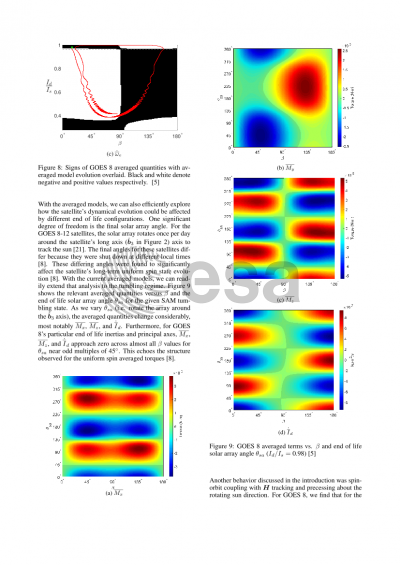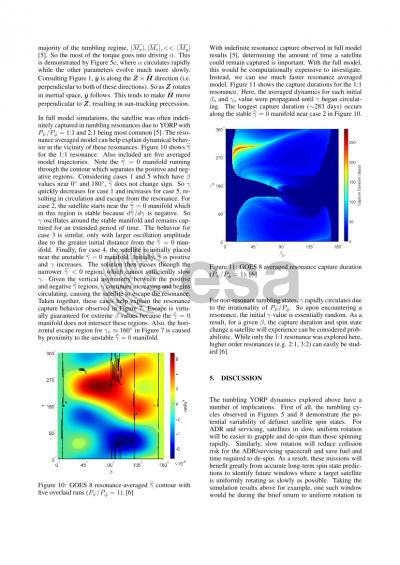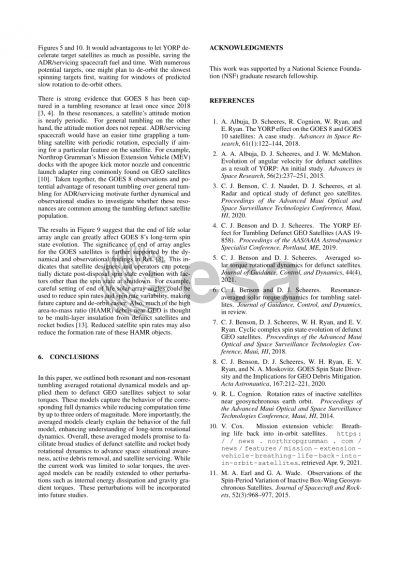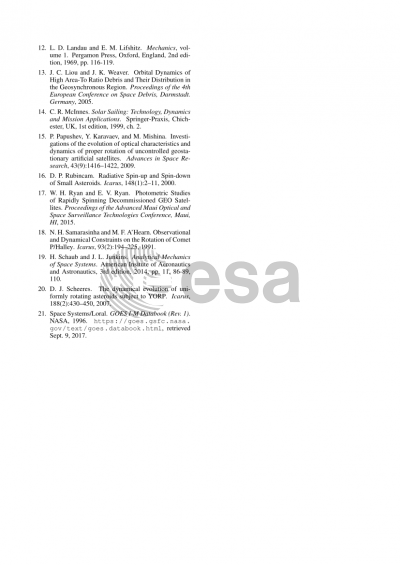Document details

Abstract
Understanding and predicting the long-term rotational dynamics of debris in geosynchronous earth orbit (GEO) is important for space situational awareness (SSA), active debris removal (ADR), and satellite servicing. The observed spin periods of defunct three-axis stabilized GEO satellites range from tens of seconds to tens of minutes with uniform and non-principal axis rotation (i.e. tumbling) observed [1-5]. For some satellites, these spin periods change significantly over a matter months with transitions from uniform to non-principal axis rotation [2,3,5,6]. Recent dynamical modeling and observations have shown that defunct GEO satellite rotational dynamics are largely driven by solar and thermal re-emission torques via the Yarkovsky-O’Keefe-Radzievskii-Paddack (YORP) effect [6-7]. Dynamical modeling of the satellite YORP effect with Euler’s equations has uncovered rich dynamical structure with repeated cycling between uniform rotation and tumbling, rotational angular momentum sun-tracking, tumbling resonances, and stable tumbling states when internal energy dissipation is considered [8]. These behaviors are consistent with observed evolution of defunct GEO satellites [3,5,7]. Unfortunately, full dynamics models (e.g. Euler’s equations) greatly hinder further exploration and understanding of general long-term rotational dynamics. These equations are slow to numerically propagate over multi-year timescales. In addition, they are expressed in terms of fast variables (instantaneous attitude and angular velocity) rather than slow variables (e.g. rotational angular momentum vector and kinetic energy) which are of much greater interest for long-term study.
In long-term orbital dynamics research, an averaged approach is often used where the Lagrange/Gauss planetary equations, written in terms slowly-varying osculating orbital elements, are averaged over the satellite mean anomaly and luni-solar motions. This averaging process yields fast, sufficiently accurate dynamical models well-suited for long-term study. In this paper, we outline and explore an analogous averaged framework for osculating rotational elements. Taking the rotational angular momentum vector and kinetic energy as our elements, we analytically average the corresponding dynamical equations over the satellite’s general torque-free rotation, expressed in terms of Jacobi elliptic functions. We find that the resulting tumbling-averaged YORP dynamics capture the rich behavior of the full dynamics simulations with a roughly three order of magnitude decrease in computation time. The averaged dynamics also uncover the mechanisms driving these behaviors and their dependence on satellite characteristics (e.g. moments of inertia, reflective properties, end of life solar panel angles). Considering specific resonances between a tumbling satellite’s two fundamental periods, the averaged approach also explains the conditions for resonant capture.
The averaged framework allows for easy incorporation of additional averaged perturbations including internal energy dissipation from flexure/fuel slosh as well as gravity gradient and magnetic torques. In a full dynamics framework for example, momentum-conserving energy dissipation generally requires multi-body models which can be computationally expensive and prohibitive for long-term studies. In our averaged framework on the other hand, one can account for dissipation by simply adding a term to the kinetic energy rate equation. Overall, the increased computational efficiency of this averaged framework promises to advance our understanding of long-term defunct satellite rotational dynamics by facilitating broad exploration. With end of life solar array angles greatly influencing long-term spin state evolution of the defunct GOES 8-12 satellites [7], satellite operators could conduct parameter searches with this framework to find the end of life conditions that minimize post-disposal spin rates and variability. This would help reduce debris shedding and greatly assist ADR and satellite servicing. Given the diverse and variable spin states of GEO debris, this framework could also be used to predict population-wide spin state distributions, valuable information for SSA and ADR/servicing efforts.
[1] Papushev, P., et al., Advances in Space Research, Vol. 43, 2009, pp. 1416–1422.
[2] Cognion, R. L., AMOS Conference, Maui, HI, 2014.
[3] Benson, C. J., et al., AMOS Conference, Maui, HI, 2018.
[4] Rachman, A., Schildknecht, T., and Vananti, A., 69th IAC, Bremen, Germany, 2018.
[5] Benson, C. J., et al., AMOS Conference, Maui, HI, 2020.
[6] Albuja, A., et al., Advances in Space Research, Vol. 61, 2018, pp. 122–144.
[7] Benson, C. J., et al., Acta Astronautica, Vol. 167, 2020, pp. 212–221.
[8] Benson, C. J., Scheeres, D. J., AAS/AAIA Astrodynamics Specialist Conference, Portland, ME, 2019.
Preview
